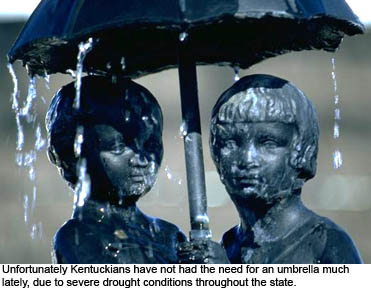Record Drought Prompts Crop, Lawn, Water Concerns
Record Drought Prompts Crop, Lawn, Water Concerns


University of Kentucky Agricultural Meteorologist Tom Priddy said the period of February through May has been the second driest in 113 years and June is not looking any better with much of the state in severe hydrologic drought.
“We had just over 10 inches of precipitation from February through May and normally we get about 4 inches per month during that time,” Priddy said. “The only other year that was drier during that period was back in 1941 with just over 6 inches.”
Priddy said the most recent Palmer Drought Severity Index put western Kentucky into severe drought status. The eastern part of the state was already in the severe category and the Bluegrass is right on the verge of moving from moderate to severe. Central Kentucky fared the best, but still is deep into moderate drought status, needing more than 7 inches above normal rainfall to recover.
As a result, the Kentucky Division of Water issued a water shortage watch for 61 counties in the state. A watch status means citizens in the water shortage watch area should prepare to reduce non-essential uses of water if asked to do so by their water providers.
In times of drought, Kentuckians naturally have concerns about everything from crop survival to drinking water supplies and lawn care. Priddy said spotty thunderstorms can go a long way in helping agricultural pursuits.
“Even though we are now in both hydrologic and agricultural drought, and crop moisture is reported to be abnormally dry with prospects declining, we can still have a good crop year,” he said. “I’ve seen years where we had record crops in times of drought. A lot of that really depends on getting showers and thunderstorms. Unfortunately spotty thunderstorms don’t usually do anything to help hydrologic, or drinking water, drought.”
Lawns, depending on the types of grasses, can make it through most times of drought. UK College of Agriculture Turf Specialist A.J. Powell said one of the most important things homeowners can do is selectively water their lawns.
“If you started watering your lawn weekly, you probably have a green lawn but you may be starting to see financial ramifications,” Powell said. “If most people let their lawns go brown, they may look terrible but most will recover when we start getting rain. You’re really better off not watering as opposed to sporadic watering that could do more damage than good.“
Although Powell said most lawns could recover, some homeowners may have variety –specific questions about lawns comprised primarily of Kentucky bluegrass and tall fescue.
"When (Kentucky bluegrass or tall fescue) lawns go completely brown, with little or no green leaves showing, you can expect some kill or severe thinning of the grass," he said. "Kentucky bluegrass is more quickly injured than tall fescue but both grasses may die."
Perennial ryegrass lawns seldom will survive such heat and drought, but Bermuda grass and zoysia grass lawns should have no problem. Fine fescue, growing in semi- shady locations, usually becomes dormant and recovers before the following spring.
“Low maintenance lawns with a mixture of turfgrasses and weeds, and or lawns rarely fertilized with nitrogen, usually will recover,” he said. “They certainly won't get better, but you will not likely need to reseed.”
Portions of a lawn with good soil, protected by moderate shade and north-facing slopes are more likely to survive. Very sandy and heavy clay lawns suffer the most damage.
“It's important to remember that proper irrigation greatly will aid the lawn during very hot weather,” Powell offered. “However, if a lawn is over watered, and then suddenly the water is cut off (during the heat and drought), it usually doesn’t have a great chance of survival. When this type of lawn turns brown, it is best to plan on reseeding.”
With possible water restrictions looming if Kentucky doesn’t receive more rain soon, it’s always a good idea to be a good water steward and conserve as much as possible.
According to Kentucky American Water Company, the average Kentuckian uses approximately 168 gallons of water per day, with only one gallon of that used for drinking and cooking.
The UK Cooperative Extension Service recommends several simple ways to conserve water at home including turning off the water while brushing teeth and washing hands, limiting showers to five minutes, using five or fewer inches of water for tub baths, repairing leaking faucets, checking for toilet leaks, washing full loads of clothes, using a pan or sink of water to wash and rinse dishes and then using rinse water to water plants, setting automatic clothes and dishwashers to a shorter cycle if possible, using a small pool for outside water play instead of a sprinkler or water hose, and keeping a bottle or pitcher of drinking water in the refrigerator instead of running the faucet until water is cool.
Priddy said the immediate future doesn’t look very wet with a forecast of above normal temperatures and below normal rainfall through at least July 2.
“We could still get remnants from tropical storms that develop in the Atlantic and that could help the situation,” he said.
For more information about drought conditions in Kentucky, please visit the UK College of Agriculture Weather Center’s Drought Information Web site. The page offers drought condition updates, historical information and forecasts, and has a way for those with questions to “Ask the Experts” about drought related issues. Submitted questions will be submitted to UK College of Agriculture experts depending on subject matter. The Kentucky Division of Water maintains a drought monitoring center Web site. The page shows current water supply shortage watches, warnings and emergencies.
